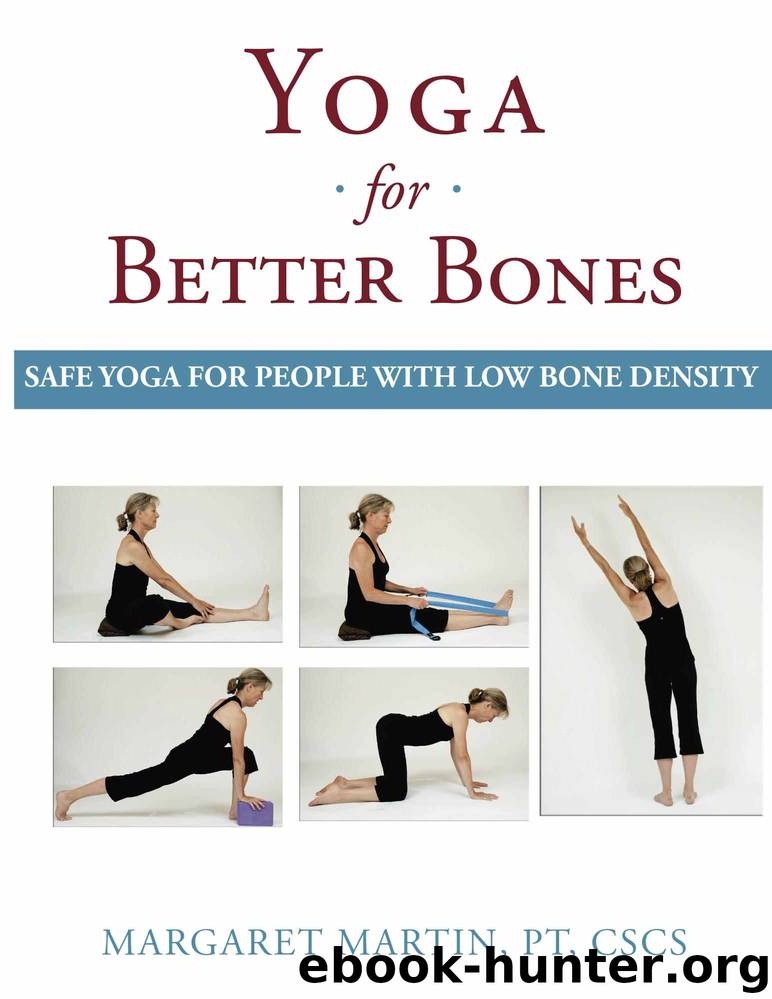Yoga for Better Bones: Safe Yoga for People with Osteoporosis by Margaret Martin

Author:Margaret Martin [Martin, Margaret]
Language: eng
Format: azw3, epub
Tags: BODY, MIND & SPIRIT / Yoga see HEALTH & FITNESS / Yoga
Publisher: Kamajojo Press
Published: 2016-07-05T16:00:00+00:00
2. Certain Yoga Poses Increase Fracture Risk
When bone density decreases, it decreases more in bones that have a higher composition of cancellous bone. The vertebral body, in the spine, is one such area. It has a very high percentage of cancellous bone. As a result, people with low bone density or osteoporosis have a very high risk of fracture in the body of the vertebra.
Studies have shown that slouching postures and exercises that place the spine in a forward bend position can impose large loads on the front of vertebral bodies. Newer research is showing that there are a greater number of trabeculae in the back half of the vertebral bodies. This means that the front of the vertebrae is not as strong as the back and is at more risk of fracture.
The vertical trabeculae in our vertebral bodies bow slightly when loaded. Loads too great will snap the trabeculae. This means that the load of your head and upper body must then be borne by a smaller cross-section of trabeculae. With each micro fracture, the vertebra weakens and eventually the outer shell (the cortical bone) collapses. The recommendations provided in Chapters 5, 6, and 7 of this book are made to protect you from these types of fractures.
Fractures From Everyday Movement and Yoga
We often read in the news about falls or traumatic accidents that result in fractures. This book is about the other type of fractures – those that occur in everyday activities and in your Yoga routine, and what you can do to reduce the risk of fracture. These are the “silent” fractures that occur slowly and gradually. They are the result of how we move, how we carry ourselves, and how we practice Yoga.
I have had many clients confidently report to me that they never had any fractures but then email me their X-ray findings that show they have “compressions” or “wedges”. Osteoporotic fractures are so common that radiologists have started giving them these alternative names. Compressions and wedges are fractures of the vertebra. Once you have one, your risk of a second and third goes up exponentially.
Although they may be “silent” when they first occur, the sequelae of conditions that result from multiple fractures of the spine is not silent. It affects your digestion, your breathing, your posture, and for some their self-esteem. You lose your ability to stand as tall as you once did. Clothes fit differently. Your centre of gravity changes – placing more challenges on your balance.
Although hip fractures occur less frequently than vertebral fractures, they are certainly not silent. Hip fractures are painful, immediately disabling, and only 25% of individuals who recover from a hip fracture return to their previous level of function.
The risks of accidental traumatic type of fractures can be hard to eliminate. However, we can do things to reduce the slow, insidious fractures that occur from everyday movement and from Yoga.
Story of Jane
Let’s look at a possible scenario. Jane is in her fifties. Her Physician recently informed her that she has osteopenia.
Download
Yoga for Better Bones: Safe Yoga for People with Osteoporosis by Margaret Martin.epub
This site does not store any files on its server. We only index and link to content provided by other sites. Please contact the content providers to delete copyright contents if any and email us, we'll remove relevant links or contents immediately.
Periodization Training for Sports by Tudor Bompa(8170)
Bodyweight Strength Training by Jay Cardiello(7841)
Born to Run: by Christopher McDougall(7065)
Inner Engineering: A Yogi's Guide to Joy by Sadhguru(6725)
Asking the Right Questions: A Guide to Critical Thinking by M. Neil Browne & Stuart M. Keeley(5636)
The Fat Loss Plan by Joe Wicks(4847)
Bodyweight Strength Training Anatomy by Bret Contreras(4613)
Yoga Anatomy by Kaminoff Leslie(4306)
Dynamic Alignment Through Imagery by Eric Franklin(4118)
Science and Development of Muscle Hypertrophy by Brad Schoenfeld(4089)
ACSM's Complete Guide to Fitness & Health by ACSM(3989)
Exercise Technique Manual for Resistance Training by National Strength & Conditioning Association(3956)
The Four-Pack Revolution by Chael Sonnen & Ryan Parsons(3932)
Bodyweight Strength Training: 12 Weeks to Build Muscle and Burn Fat by Jay Cardiello(3915)
The Ultimate Bodybuilding Cookbook by Kendall Lou Schmidt(3886)
Yoga Anatomy by Leslie Kaminoff & Amy Matthews(3863)
American Kingpin by Nick Bilton(3757)
Nutrition for Sport, Exercise, and Health by Spano Marie & Kruskall Laura & Thomas D. Travis(3715)
Yoga Therapy by Mark Stephens(3703)
